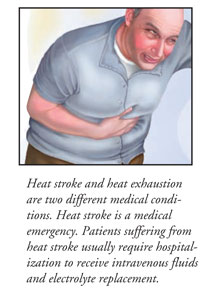
Two Related Conditions
Heat exhaustion and heat stroke are two conditions that can result from exposure to high environmental temperatures for brief or extended periods of time. In these conditions, the body cannot compensate for the excess heat and cannot effectively cool itself through sweating. This is often the case during extreme exertion in the heat, causing increased heat production by the muscles. It is also more common when humidity levels are high, which makes it more difficult for the body to cool off by sweating. People most susceptible to heat-related illnesses are the very young or very old, those who suffer from a chronic disease, including obesity or alcoholism, and those who take certain prescription drugs, such as antihistamines, anticholinergics, or psychoactive drugs. Heat related illnesses can be prevented by drinking sufficient fluids and allowing the body’s natural sweating mechanism to keep skin cool by wearing lightweight, loose-fitting, or mesh clothing. Exertion should be avoided in hot environments whenever possible. If it cannot be avoided, strenuous activity should be paced with frequent rests or postponed until the cooler part of the day.
Heat Stroke Is an Emergency
Excessive heat exposure causes thousands of deaths in the United States every year, more than most natural disasters combined. Although the very young and very old, those with chronic diseases, and those taking psychoactive drugs are at higher risk, young and healthy people can also suffer from heat-related conditions. When the body cannot effectively cool itself in an extremely hot environment, body temperature can rise quickly. This often occurs when humidity in the air is high, leading to poor evaporation of sweat. Body temperatures can rise rapidly, causing damage to the brain and other vital organs. Heat-related illnesses can occur over a period of days or after just a few hours of exposure to extreme heat. It is important to recognize the difference in the symptoms of heat exhaustion (a milder form of heat-related illness) and heat stroke (more serious, a medical emergency) in order to help someone affected by these conditions. They have different symptoms and require different treatment.
Heat exhaustion:
A person may develop heat exhaustion after several days of hot weather or high air temperatures and not drinking enough fluids, which leads to water and/or salt depletion and dehydration. Symptoms of heat exhaustion are pale, sweaty skin, muscle cramps, weakness, fainting, dizziness, headache, nausea, and vomiting. The person with heat exhaustion has cool, clammy skin, a fast heartbeat, and fast, shallow breathing. With rest, a cooling shower or bath, air conditioning, and cool fluids such as sports beverages or water taken every few minutes, heat exhaustion is usually treated successfully. If the symptoms last longer than one hour after treatment has begun, medical attention is necessary.
Heat stroke:
Heat stroke is potentially deadly, resulting from a rapid rise in body temperature and a failure of the body to sweat and cool itself. This condition can develop from heat exhaustion that is not treated. Heat stroke is a medical emergency that requires immediate treatment by medical personnel. People most likely to develop heat stroke are the elderly, the very young (under 4 years), obese persons, those with chronic diseases such as heart disease or diabetes, and patients requiring medications that can interfere with the body’s ability to cool itself. (Those drugs include anticholinergics, antiparkinsonian drugs, tranquilizers, and some antihistamines.) It may take several days of exposure to high temperatures to develop heat stroke, but when it begins, the body temperature can rise within minutes to dangerous levels. Heat stroke is more common when high temperatures are combined with high humidity. The symptoms of heat stroke include red, hot, dry skin (without sweating), dizziness, confusion, unconsciousness, low blood pressure, fast heartbeat, headache, and very high body temperatures (oral temperature can reach over 106°F). It is this rise in body temperature that can result in permanent brain damage, damage to other organs such as the kidneys, convulsions, and death. Emergency medical personnel should be notified right away if a person has these symptoms. First aid treatment for heat stroke should include removing the patient from the hot environment, wetting the body in any way possible to help bring down the temperature, and using a cooling fan if possible. Body temperature should be assessed every 10 minutes and cooling should continue until it lowers to 101°F to 102°F. As the body temperature comes down, victims of heat stroke may have seizures.






